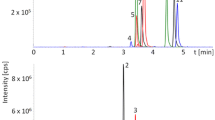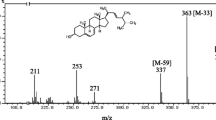Abstract
A fundamental step in addressing the global problem of mycotoxins is the development of highly sensitive, multi-class extraction and detection methods. This constitutes a field of research that has in recent years enjoyed a steady advance. Such methods, generally based on liquid chromatography coupled to mass spectrometry, are widely reported successfully detecting various mycotoxins in different food and feed samples. In this work, an innovative approach to multi-class mycotoxin control is proposed, offering specific advantages: a broader inclusion of more mycotoxin classes, robust and thorough extraction for all target compounds despite their varied chemical properties, and determination of all analytes from a single injection. The method involved the extraction and quantification of the main mycotoxins produced by Aspergillus, Fusarium, and Penicillium fungi, as well as their reported derivatives, together with 12 other compounds most commonly produced by Claviceps purpurea. The popularly reported QuEChERS technique has been reduced to a simple “salting-out liquid-liquid extraction” (SO-LLE) to obtain the most efficient extraction of the aforementioned mycotoxin classes in a very short time. This is in particular extremely important in ensuring correct determination of individual ergot alkaloids, for which short and robust sample preparation as well as short analytical sequences were key for minimizing the epimerization during analysis. The analyses of wheat and maize samples were performed using ultra-high performance liquid chromatography coupled with tandem mass spectrometry. Matrix-matched calibration curves were established and limits of quantification were below the maximum levels established by the EU regulation. The precision (repeatability and intermediate precision) was lower than 13% in all cases and recoveries ranged between 60 and 98% in maize and between 62 and 103% in wheat, fulfilling the current legislation. The method was applied to study the co-occurrence of these mycotoxins in wheat (n = 13) and maize (n = 15) samples from six European countries. A successful quantification of 23 different mycotoxins, from all major classes, in 85% of wheat and 93% of maize samples was achieved.

Similar content being viewed by others
References
RASFF annual report. 2015. https://ec.europa.eu/food/sites/food/files/safety/docs/rasff_annual_report_2015.pdf. Accessed 10 Nov 2016.
Miller JD. Significance of grain mycotoxins for health and nutrition. In: Champ BR, Highley E, Hocking AD, Pitt JI, editors. Fungi and mycotoxins in stored products. Canberra: ACIAR Proceedings; 1991. p. 126–35.
Smith MC, Madec S, Coton E, Hymery N. Natural co-occurrence of mycotoxins in foods and feeds and their in vitro combined toxicological effects. Toxins. 2016;8:94.
Alassane-Kpembi I, Kolf-Clauw M, Gauthier T, Abrami R, Abiola FA, Oswald IP, et al. New insights into mycotoxin mixtures: the toxicity of low doses of type B trichothecenes on intestinal epithelial cells is synergistic. Toxicol Appl Pharm. 2013;272:191–8.
Alassane-Kpembi I, Puel O, Oswald IP. Toxicological interactions between the mycotoxins deoxynivalenol, nivalenol and their acetylated derivatives in intestinal epithelial cells. Arch Toxicol. 2015;89:1337–46.
Marroquín-Cardona AG, Johnson NM, Phillips TD, Hayes AW. Mycotoxins in a changing global environment—a review. Food Chem Toxicol. 2014;69:220–30.
Speijers GJ, Speijers MH. Combined toxic effects of mycotoxins. Toxicol Lett. 2004;153:91–8.
Regulation (EC) No. 1881/2006 setting maximum levels for certain contaminants in foodstuffs. Off J Eur Communities 2006;L364:5–24.
Arroyo-Manzanares N, Huertas-Perez JF, Garcia-Campaña AM, Gamiz-Gracia L. Simple methodology for the determination of mycotoxins in pseudocereals, spelt and rice. Food Control. 2014;36:94–101.
Njumbe Ediage E, Diana Di Mavungu J, Van Peteghem C, De Saeger S. A validated multi-analyte LC–MS/MS method for the quantification of 25 mycotoxins in cassava flour, peanut cake and maize samples. J Agric Food Chem. 2011;59:5173–80.
Njumbe Ediage E, Van Poucke C, De Saeger S. A multi-analyte LC–MS/MS method for the analysis of 23 mycotoxins in different sorghum varieties: the forgotten sample matrix. Food Chem. 2015;177:397–404.
Al-Taher F, Cappozzo J, Zweigenbaum J, Lee HJ, Jackson L, Ryu D. Detection and quantitation of mycotoxins in infant cereals in the U.S. market by LC-MS/MS using a stable isotope dilution assay. Food Control. 2017;72:27–35.
Commission Recommendation of 15 March 2012 on the monitoring of the presence of ergot alkaloids in feed and food (2012/154/EU). Off J Eur Communities 2012;L77:20–21.
Zachariasova M, Dzuman Z, Veprikova Z, Hajkova K, Jiru M, Vaclavikova M, et al. Occurrence of multiple mycotoxins in European feeding stuffs, assessment of dietary intake by farm animals. Anim Feed Sci Technol. 2014;193:124–40.
Malachová A, Sulyok M, Beltrán E, Berthiller F, Krska R. Optimization and validation of a quantitative liquid chromatography–tandem mass spectrometric method covering 295 bacterial and fungal metabolites including all regulated mycotoxins in four model food matrices. J Chromatogr A. 2014;1362:145–56.
Sulyok M, Krska R, Schuhmacher R. A liquid chromatography/tandem mass spectrometric multi-mycotoxin method for the quantification of 87 analytes and its application to semi-quantitative screening of moldy food samples. Anal Bioanal Chem. 2007;389:1505–23.
Diana Di Mavungu J, Malysheva SV, Sanders M, Larionova D, Robbens J, Dubruel P, et al. Development and validation of a new LC–MS/MS method for the simultaneous determination of six major EAs and their corresponding epimers. Application to some food and feed commodities. Food Chem. 2012;135:292–303.
Commission Decision of 12 August 2002 implementing Council Directive 96/23/EC concerning the performance of analytical methods and the interpretation of results (2002/657/EC). Off J Eur Communities 2002;L221:8–36.
Anastassiades M, Lehotay SJ, Stajnbaher D, Schenck FJ. Fast and easy multiresidue method employing acetonitrile extraction/partitioning and “dispersive solid-phase extraction” for the determination of pesticide residues in produce. J AOAC Int. 2003;86:412–31.
De Boevre M, Diana Di Mavungu J, Maene P, Audenaert K, Deforce D, Haesaert G, et al. Development and validation of an LC-MS/MS method for the simultaneous determination of deoxynivalenol, zearalenone, T-2-toxin and some masked metabolites in different cereals and cereal-derived food. Food Addit Contam Part A Chem Anal Control Expo Risk Assess. 2012;29:819–35.
Wenzl T, Haedrich J, Schaechtele A, Robouch P, Stroka J, Guidance document on the estimation of LOD and LOQ for measurements in the field of contaminants in feed and food; EUR 28099, Publications Office of the European Union, Luxembourg, ISBN 978-92-79-61768-3; 2016 https://doi.org/10.2787/8931.
Koesukwiwat U, Sanguankaew K, Leepipatpiboon N. Evaluation of a modified QuEChERS method for analysis of mycotoxins in rice. Food Chem. 2014;153:44–51.
Zhou Q, Li F, Chen L, Jiang D. Quantitative analysis of 10 mycotoxins in wheat flour by ultrahigh performance liquid chromatography-tandem mass spectrometry with a modified QuEChERS strategy. J Food Sci. 2016;81:T2886–90.
Mohamed R, Gremaud E, Rychoz-Payot J, Tabet J-C, Guy PA. Quantitative determination of five ergot alkaloids in rye flour by liquid chromatography–electrospay ionisation tandem mass spectrometry. J Chromatogr A. 2006;1114:62–72.
Müller C, Kemmlein S, Klaffke H, Krauthause W, Preiß-Weigert A, Wittkowski R. A basic tool for risk assessment: a new method for the analysis of ergot alkaloids in rye and selected rye products. Mol Nutr Food Res. 2009;53:500–7.
Remiro R, Gonzalez-Peñas E, Lizarraga E, Lopez de Cerain A. Quantification of ochratoxin A and five analogs in Navarra red wines. Food Control. 2012;27:139–45.
Carpio A, Arroyo-Manzanares N, Ríos-Moreno A, Garrido-Jurado I, Gámiz-Gracia L, García-Campaña AM, et al. Development of a QuEChERS-based extraction method for the determination of destruxins in potato plants by UHPLC-MS/MS. Talanta. 2016;146:815–22.
Commission Recommendation of 27 March 2013 on the presence of T-2 and HT-2 toxin in cereals and cereal products (2013/165/EU). Off J Eur Communities 2013;L91:12–15.
Kokkonen MK, Jestoi MN. A multi-compound LC-MS/MS method for the screening of mycotoxins in grains. Food Anal Methods. 2009;2:128–40.
Commission Regulation (EC) No. 401/2006 of laying down the methods of sampling and analysis for the official control of the levels of mycotoxins in foodstuffs. Off J Eur Communities 2006;L70:12–34.
Acknowledgements
The authors thank the Spanish Ministry of Economy and Competitiveness (Project Ref: AGL2015-70708-R). Natalia Arroyo-Manzanares received a post-doctoral grant from the University of Granada.
Author information
Authors and Affiliations
Corresponding author
Ethics declarations
Conflict of interest
The authors declare that they have no conflict of interest.
Additional information
Published in the topical collection Food Safety Analysis with guest editor Steven J. Lehotay.
Electronic supplementary material
ESM 1
(PDF 133 kb)
Rights and permissions
About this article
Cite this article
Arroyo-Manzanares, N., De Ruyck, K., Uka, V. et al. In-house validation of a rapid and efficient procedure for simultaneous determination of ergot alkaloids and other mycotoxins in wheat and maize. Anal Bioanal Chem 410, 5567–5581 (2018). https://doi.org/10.1007/s00216-018-1018-6
Received:
Revised:
Accepted:
Published:
Issue Date:
DOI: https://doi.org/10.1007/s00216-018-1018-6




